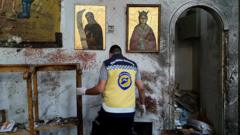What Led to the Deadly Suicide Bombing at a Damascus Church That Killed 20?

# Understanding the Recent Tragedy in Dweila: A Deep Dive into the Church Bombing in Damascus
The tragic events that unfolded at Mar Elias Church in Dweila, Syria, have left a profound impact on the local and global community. With reports stating that at least 20 people lost their lives and 52 others were wounded due to a suicide bombing during a service, this incident not only highlights the ongoing violence in Syria but also raises significant questions about the security and stability of the region.
This article aims to dissect the details of the attack, examine the implications of such violence on the Syrian society, and explore the broader context of religious tensions in the region.
## The Attack: A Detailed Account
On a seemingly normal day, chaos erupted in Mar Elias Church as an attacker affiliated with the jihadist group Islamic State (IS) infiltrated a service. The initial phase involved shooting, which triggered panic among the congregants. Eyewitness accounts describe a scene of horror as individuals attempted to thwart the attack before the assailant detonated an explosive vest.
### Eyewitness Reports
- **Chaos and Fear**: One congregant recounted how the assailant entered carrying a weapon and began firing. Efforts to stop him were made, but the tragedy concluded with the attacker detonating the explosives.
- **Destruction**: Images and videos shared by the Syrian Civil Defence, known as the White Helmets, depict the aftermath: a heavily damaged altar, shattered pews, and a bloodied floor, painting a bleak picture of the violence that occurred.
### The Immediate Response
Security forces swiftly cordoned off the area around the church to initiate a thorough investigation into the bombing. The Syrian interior ministry confirmed the attack, marking it as the first significant act of violence in Damascus since the tumultuous events that led to the ousting of President Bashar al-Assad by rebel forces in December.
## The Broader Context of Violence in Syria
The attack on Mar Elias Church is not an isolated incident; it is part of a larger narrative of sectarian violence that has plagued Syria for years.
### Historical Background
Since the onset of the Syrian Civil War in 2011, the country has experienced immense upheaval, characterized by the struggle for power among various factions, including government forces, rebel groups, and extremist organizations like IS.
- **Sectarian Violence**: Syria is home to a mosaic of religious and ethnic communities, including Sunni Muslims, Alawites, Christians, and Kurds. The civil war has exacerbated sectarian divisions, leading to widespread violence and distrust among these groups.
### Recent Developments
In recent months, Syria has witnessed two waves of deadly sectarian violence. Despite promises from interim leaders like Ahmed al-Sharaa, the situation for religious and ethnic minorities remains precarious.
- **HTS and Its Promises**: As the head of a Sunni Islamist group and a former al-Qaeda affiliate, al-Sharaa has reassured the public of their commitment to safeguarding all communities. However, the reality on the ground often tells a different story.
## The Impact on Religious and Ethnic Minorities
The implications of such attacks extend beyond immediate casualties. They exacerbate fears among religious and ethnic minorities regarding their safety and future in Syria.
### Fear and Distrust
- **Community Tensions**: Incidents like the attack on Mar Elias Church can lead to increased mistrust among different religious groups. Minorities fear becoming targets, leading to social fragmentation.
- **Emigration**: Many individuals from religious minorities are considering emigration as a means of escaping violence and uncertainty. This migration contributes to the brain drain of the region, depriving Syria of valuable human resources.
### Psychological Effects
The psychological toll on survivors and the broader community cannot be understated. Survivors of such attacks often experience:
- **Post-Traumatic Stress Disorder (PTSD)**: Witnessing violence, losing loved ones, and living in a climate of fear can lead to long-lasting mental health issues.
- **Community Trauma**: The collective trauma experienced by a community can hinder recovery and reconciliation efforts, further embedding divisions.
## Security Measures and Future Implications
In light of the recent tragedy, questions surrounding security measures in Syria are more pressing than ever.
### Government Response
- **Increased Security**: The Syrian government may respond to this incident with heightened security protocols, particularly around places of worship.
- **Intelligence Operations**: Enhanced intelligence operations could be implemented to thwart future attacks from extremist groups.
### Community Resilience
Despite the overwhelming challenges, communities in Syria have shown resilience.
- **Interfaith Initiatives**: Various organizations are working to promote interfaith dialogue and cooperation among different religious groups in a bid to foster understanding and peace.
- **Grassroots Efforts**: Local communities are mobilizing to create safe spaces, protect their heritage, and promote coexistence.
## Conclusion
The tragic bombing at Mar Elias Church is a stark reminder of the fragility of peace in Syria. As the world watches, the need for a comprehensive approach to address sectarian violence, enhance security, and foster community resilience is paramount.
In a country rife with turmoil, every act of violence deepens the wounds of a society longing for healing and stability.
As we reflect on this tragedy, we must consider: How can communities come together to promote peace in a landscape marked by division?
### FAQs
What happened during the bombing at Mar Elias Church?
The bombing occurred when an attacker entered the church during a service, opened fire, and detonated an explosive vest, resulting in numerous casualties.Who was responsible for the attack?
The attacker was reported to be affiliated with the jihadist group Islamic State (IS).What are the implications of this attack on religious minorities in Syria?
The attack exacerbates fears among religious minorities and can lead to increased sectarian tensions, distrust, and potential emigration.How is the Syrian government responding to increased violence?
The Syrian government is likely to enhance security measures around places of worship and may implement increased intelligence operations to prevent future attacks. As we navigate the complexities of the situation in Syria, the call for unity and understanding among diverse communities becomes ever more critical. #Syria #Peace #CommunityResiliencePublished: 2025-06-22 18:58:18 | Category: technology



